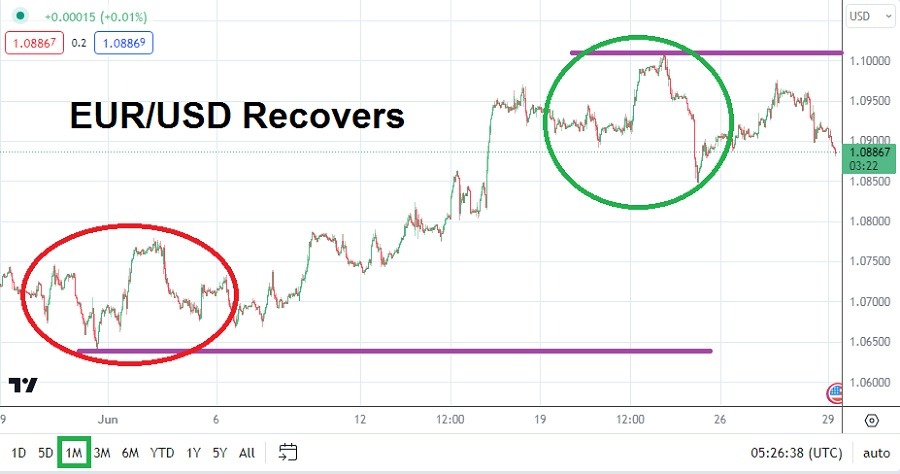The EUR/USD has seen a solid recovery upwards of value the past four weeks as the both the ECB and U.S Fed have sparked reactions in Forex.
The EUR/USD was trading near the 1.06600 level on the 1st of June and reached a high of nearly 1.10130 on the 22nd. The EUR/USD is trading near the 1.8900 level as of this writing and traders can clearly see the currency pair has made a rather significant climb. Speculators who pursued upwards momentum early in June based on the notion they believed the currency pair was oversold likely had a few solid weeks of returns if they used appropriate risk management.
Forex Brokers We Recommend in Your Region
Behavioral sentiment which believed the U.S Federal Reserve would not raise its Federal Funds Rate in June was proven correct. Traders who also felt the European Central Bank would raise their borrowing rates saw this happen. The effect of no hike from the Fed, followed with an increase from the ECB certainly helped the EUR/USD climb. Making the momentum stronger in the middle of June was the rather lackluster FOMC Statement from the U.S Fed saying it ‘might’ consider raising interest rates in July, while the ECB made it clear more interest rate hikes were likely.
While highs made about a week ago in the EUR/USD when the currency pair climbed above the 1.10125 mark briefly was a solid result, momentum suddenly started to shift downwards again. Speculators who has a vision of the EUR/USD breaking significant mid-term resistance levels were met head on by fundamental data from the U.S which showed inflation remains remarkably stubborn, and only a couple of days ago U.S Consumer Confidence numbers were higher than expected too.
The combination of rising prices while spending remains robust in the U.S certainly puts the Federal Reserve in a position in which it will have to likely consider another interest rate hike in July. This perception has seemingly caused the EUR/USD to fall from highs and break support of 1.09000, and seen the currency pair provide choppy conditions recently between the 1.08500 to 1.09000 ratios.
- Technical traders will need to keep their eyes on U.S economic data over the next few weeks.
- If inflation remains high and consumers remain rather confident this would likely spark another Federal Funds Rate increase in July, which has seemingly been priced into the EUR/USD.
- The notion the European Central Bank will remain hawkish too, may create durable support for the EUR/USD, which might allow traders to wager on short-term direction based on perceptions of technical trends.
Speculative price range for EUR/USD is 1.07890 to 1.09875
The past three months of trading have seen large wave like motions occur in the EUR/USD as financial institutions have struggled to find equilibrium, this as they have had trouble getting clarity from the U.S Federal Reserve. The downturn in value the past week followed by choppy conditions within the higher levels of the EUR/USD, which were made since early June could prove to be dangerous for traders who are seeking one way momentum with overly ambitious price targets. There seems to be a likelihood the EUR/USD could find consolidated choppy trading in July as financial institutions interpret economic data.
Trading doesn’t always present solid trends which can be followed blindly. The past few months proven difficult, however there are technical values like the beginning of June in which it was logical to assume the EUR/USD had been sold too widely. The problem comes trying to determine what is going to happen next. It appears likely the ECB and Fed are leaning towards additional interest rate hikes in July, but what might help speculators is the notion the ECB may have to remain more hawkish than the Fed over the next six months. If this proves to be the case, the EUR/USD may continue to find support levels exhibit durability and provide a place to speculate on additional movements upwards. It is a big ‘if’.
Although July is likely to be rather choppy at times based on the past week of trading, conditions may allow for some upwards momentum to boil. If the EUR/USD starts to sustain value above the 1.09000 level it may have a reason to explore higher ground, although price velocity should not be counted on to be too energetic. Conservative traders need to use tight stop losses to protect against surprises. If the EUR/USD were to fall below the 1.08500 mark this would be bearish and another test of 1.07900 could ensue. If the EUR/USD were to hit the 1.09200 mark and then produce more momentum a test of the 1.09500 could happen.
Ready to trade our monthly Forex analysis? We’ve made a list of the best brokers to trade Forex worth using.



